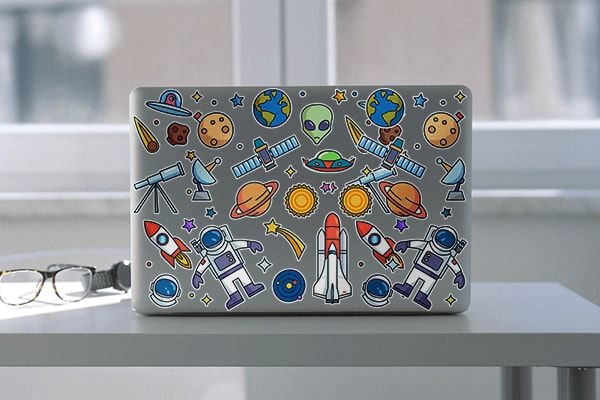What Is Decal Signage?
What Are Decals?
Decals are decorative stickers that can be applied to smooth surfaces like cars, windows, walls, laptops, and more. The word “decal” comes from the French word décalcomanie meaning the process of transferring images and designs onto a material. Decals are made from thin flexible materials like vinyl or paper and have an adhesive backing that allows them to stick to surfaces.
The origins of decal technology date back to the late 18th century in France when decalcomania became popular as a creative hobby. People would use gum arabic or varnish to transfer colorful prints and images onto various objects. By the early 1900s, decals became commercially produced and used for porcelain dinnerware decoration. Vinyl car decals emerged in the 1920s for vehicle branding. Technological improvements in the mid-1900s like screen printing and computer design revolutionized decal manufacturing, allowing for more detailed and customized designs.
Today, decals are highly versatile and used for branding, marketing, decoration, art projects, DIY crafts, and more. Modern manufacturing methods also allow for decals on unique surfaces like fabric, wood, and skin for temporary tattoos.
Types of Decals
Decals come in a variety of materials, each with their own unique properties and uses. Some of the most common types of decals include:
Vinyl
Vinyl is one of the most popular materials for decals. Vinyl decals consist of cut vinyl that is backed with an adhesive layer. They are durable and waterproof, making them suitable for both indoor and outdoor applications. Common uses for vinyl decals include vehicle graphics, window lettering, wall murals, and promotional signage (SpeedPro).
Static Cling
Static cling decals use static electricity to adhere to smooth surfaces like glass, plastic, and metal. They don’t leave behind any adhesive residue. Static cling decals are often used for temporary application on windows or as promotional materials at events. A benefit of static cling is easy removal and repositioning (Acme Graphics).
Magnetic
Magnetic decals utilize magnets to stick to ferrometallic surfaces. They allow for quick application and removal for surfaces like vehicles and metal doors or filing cabinets. Magnetic decals are durable for temporary outdoor use. They are commonly used for vehicle advertising or interior decor (Sign It Up).
Wall/Floor
Wall and floor decals are made from materials like vinyl or static cling to stick to smooth indoor surfaces. They come in a variety of shapes and designs to decorate walls, floors, ceilings, and furnishings. These decals are often reusable and allow for creative customization of living spaces.
Uses for Decals
Decals are used in a wide range of applications, but most commonly for signage, branding, decor, and providing information or labels. Some of the most popular uses for decals include:
Branding and Advertising: Decals are commonly used to display logos, branding, and advertisements on vehicles, windows, walls, floors, signs, and more. Vehicle wraps and window graphics are a popular form of mobile advertising. Retail stores may use decals for branding or sale signage in storefront windows (https://theartsyspot.com/blogs/news/uses-for-decals-functional-and-decorative-ideas).
Home and Office Décor: Wall decals and murals are popular for decorating homes and offices with graphics, quotes, shapes, and more. Decals can be used to decorate walls, floors, furniture, appliances, doors, and windows (https://theartsyspot.com/blogs/news/uses-for-decals-functional-and-decorative-ideas).
Labels and Informational Signs: Decals can provide product labels, warning signs, mandatory signs, directions, and other informational graphics. These are commonly used in schools, offices, factories, airports, parks, and public spaces (https://sttark.com/blog/decals-vs-stickers-vs-labels).
Crafts: Die-cut vinyl decals have many crafty uses for scrapbooking, cards, gifts, party decor, and more.
Special Effects: Decals create unique effects when used for “stained glass”, frosting, and texturing on glass, wood, plastic, or metal surfaces.
Overall, decals are valued for their versatility, ability to adhere to almost any surface, and graphical capabilities for branding, decorating, informing, or creating special effects.
Decal Printing Methods
There are several methods used to print decals, each with their own advantages and disadvantages.
Digital Printing
Digital printing, also known as inkjet printing, is one of the most common methods for printing custom decals (https://www.kadee.com/custom). It involves printing the decal directly onto decal paper using an inkjet printer. This allows for full color printing and photographic image reproduction. Digital printing excels at short runs and rapid prototyping, allowing for quick turnaround times. However, it generally cannot produce the same durability as other printing methods.
Screen Printing
Screen printing produces extremely durable decals by pushing ink through a fine mesh screen onto the decal medium (https://www.cornerstonesign.com/screen-printed-decals). The screens are prepared photo-mechanically, making it well suited for long runs with high precision. However, preparing the screens is more time consuming than other methods. While screen printing can incorporate multiple colors, it does not allow for photographic image reproduction.
Offset Printing
Offset printing utilizes metal plates to transfer ink onto the decal medium. It allows for high print quality and long print runs. However, like screen printing, it requires more setup time compared to digital printing. Offset printing can incorporate multiple spot colors but generally not full photographic color.
When choosing a decal printing method, digital excels at fast turnaround of short runs and custom orders while screen and offset printing offer greater durability for long production runs.
Custom Decals
Decals can be fully customized with original designs to promote a brand, display custom artwork, or share any image or text. With advancements in digital printing, it’s now easier than ever for both businesses and consumers to design and order custom decals.

Online printing services like Gold Image Printing allow you to instantly design and order custom decals through their website. These online services are convenient, fast, and affordable. You simply upload your image or artwork, customize the decal size and material, place the order, and your custom decals will be printed and shipped directly to you.
For local printing, many print shops offer custom decal services as well. You can work directly with a graphic designer to create a custom decal design. Then the print shop will print your decals onSpecialized printers allow for full-color, photographic, and high-resolution decal printing. The benefit of local printers is the ability to see sample proofs before final printing.
Whether ordering online or working with a local print shop, custom decals allow you to create unique branding, art, or messaging. With custom designs and sizes, decals can be tailored to your exact needs and specifications.
Applying and Removing Decals
Properly applying decals is crucial for getting a smooth, professional finish. Before applying, make sure the surface is clean and dry. Many professional installers recommend using isopropyl alcohol to clean the area thoroughly. When ready to apply, carefully peel away the backing paper and use a plastic applicator or squeegee to smooth the decal onto the surface, pressing out any air bubbles or wrinkles. Go slowly and methodically. Applying decals can take patience, but done properly, the end result will be flawless.
Just as important as applying decals is knowing how to remove them safely, especially from vehicles. Using sharp tools or abrasive cleaners can permanently damage the paint underneath. According to experts, a heat gun is the best tool for removing car decals. Warm the decal with the heat gun while slowly peeling up a corner. The heat allows the adhesive to release gradually without damaging the paint. Any adhesive residue left behind can be cleaned off with isopropyl alcohol. For other surfaces like windows, carefully slice the film with a razor blade then peel off. Avoid harsh chemical removers which could interact with tint films.
With care and the proper tools, decals can go on and come off without a trace. Refer to guides like Best of Signs’ “Applying and Removing Decals” for more tips.
Decal Durability
Decals can last anywhere from a few months to over 20 years depending on the material, application process, and care taken to maintain the decals. Some key factors that affect decal longevity include:
Location – Decals applied to outdoor surfaces or vehicles will have a much shorter lifespan than indoor decals due to UV exposure and weathering. According to a discussion on the Airliners Cafe forums, aircraft modelers report ATP decals lasting 1-2 years outdoors (source).
Application – Proper surface prep and application techniques, like cleaning the surface and using decal setting solutions, can dramatically increase the durability of decals. According to a Reddit thread, applying a top coat can also protect the decals and prevent peeling or fading (source).
Material – Vinyl decals tend to be the most durable, lasting over 20 years if properly cared for. Water slide decals are prone to damage if not sealed with a top coat. The material composition affects longevity.
Care – Avoiding abrasive cleaners, pressure washing, and light polishing of the decals can prevent premature wear and damage. Check decals regularly for lifting edges or fading.
Decal Regulations
When it comes to putting decals on vehicles, there are certain regulations to keep in mind. Many states have laws limiting the size, placement, and content of decals on cars, trucks, and motorcycles.
For example, most states prohibit decals from being placed on the front windshield if they obstruct the driver’s view. Common regulations include restricting front windshield decals to be no larger than 5 inches tall and located in the lower corners of the windshield (What Are the Laws on Car Decals?). Rear windshield decals may also be limited to a certain percentage of window coverage before visibility becomes an issue.
State vehicle inspection and registration stickers are required by law to be displayed, but regulations may dictate size and placement on the windshield or license plate (Police Stick to the Law When It Comes to Decals).
For commercial vehicles and storefronts, local signage and zoning regulations will dictate the allowable size and placement of decals. Safety should also be considered, avoiding obstructive or distracting decals near roads or walkways.
In all cases, offensive, discriminatory or dangerous decal content may be prohibited by law. Knowing the local decal regulations is important for proper and safe display.
Decal Design Tips
When creating custom decals, there are some key design tips to keep in mind for maximum visual impact and legibility. According to this source, choosing the right colors and outlines is crucial. Bold, contrasting colors will grab attention, while clean outlines make the decal easy to read. Metallic decals are also popular for a sleek, modern look according to this article.
It’s important to balance visual impact with legibility. This source recommends choosing easy-to-read fonts, avoiding overly complicated designs, and using decals strategically on windows and doors to maximize visibility. Consider proportion and placement – a decal needs to be large enough to read from a distance but not obstruct visibility into the business. By applying these design principles, custom decals can effectively promote any brand or message.
The Future of Decals
The decal industry is constantly evolving with new technologies and innovations. According to LinkedIn, the global vinyl sticker market is projected to experience considerable growth between 2023 and 2030 as decals continue to be utilized across industries and applications (LinkedIn).
Some key trends that are shaping the future of decals include:
- Increased durability – New materials and printing methods are enabling decals to last longer, even in outdoor settings.
- More customizable and complex designs – Digital printing allows for full color, photographic quality decals that can be made in any shape and size.
- Smart decals – Decals are being embedded with NFC tags, QR codes, and RFID technology for interactive signage.
- Sustainable materials – Eco-friendly vinyl, recycled substrates, and water-based inks are becoming more prevalent.
- Growth of vehicle wraps – Full vehicle wraps with printed graphics are gaining popularity as a moving billboard.
With versatile applications across commercial, personal, and industrial uses, the decal industry is poised for continued growth and innovation (LinkedIn). Advances in materials and printing will open up new creative possibilities for decals in the future.





